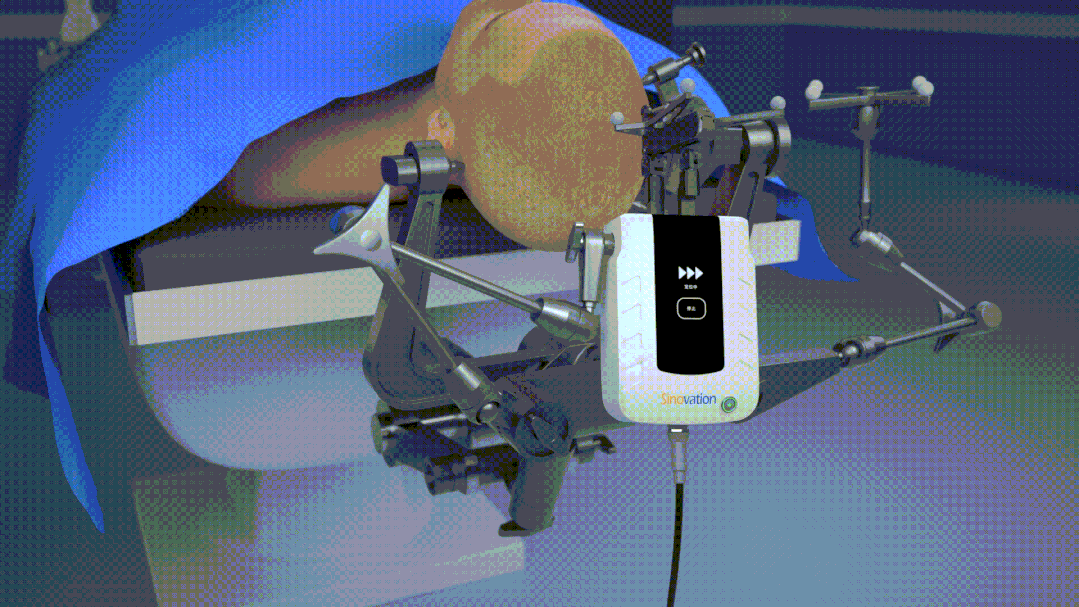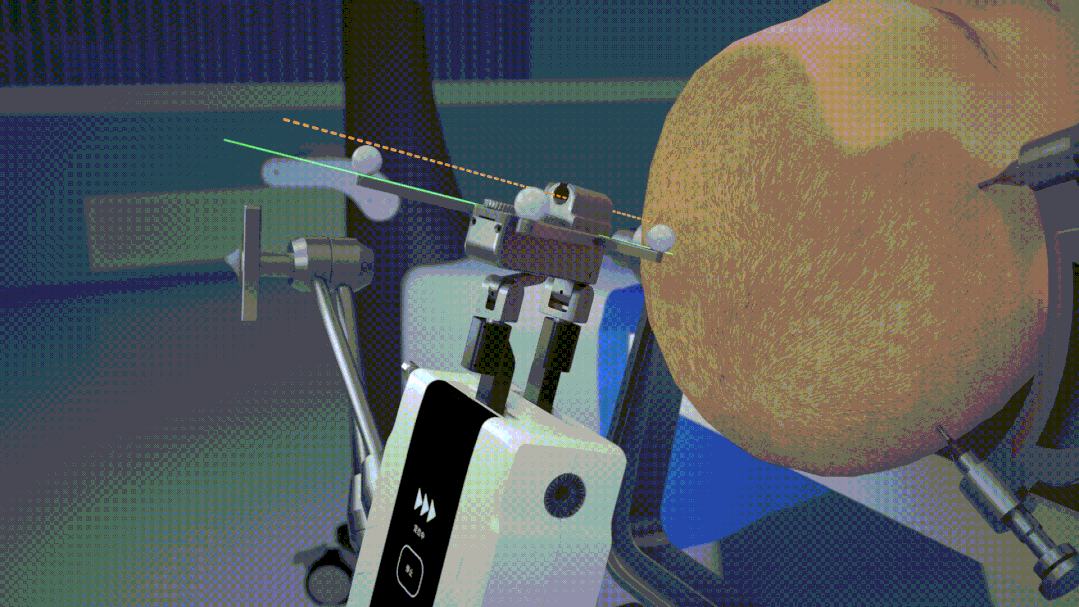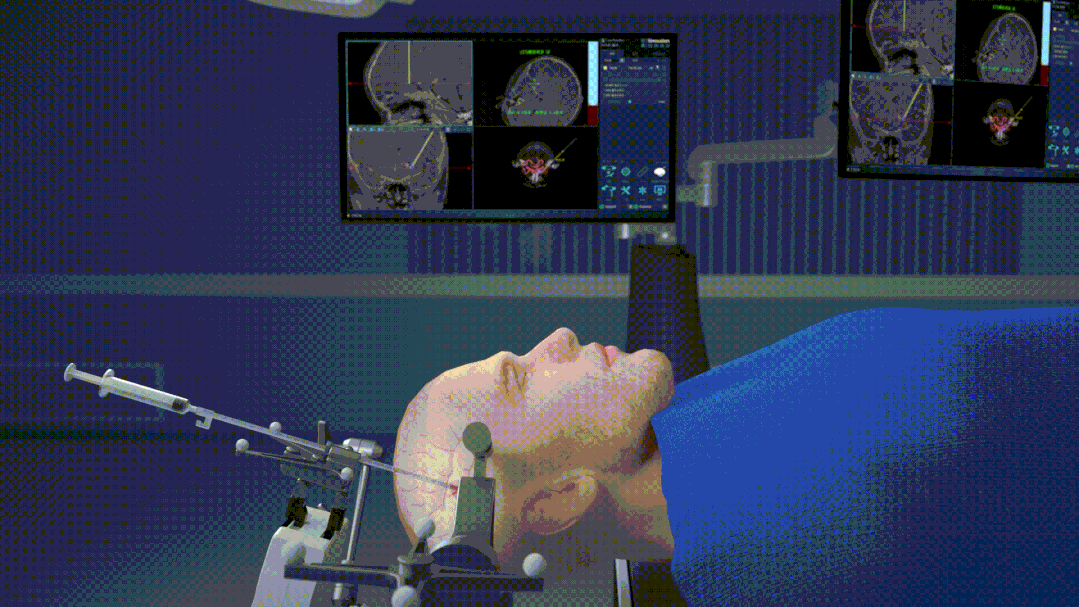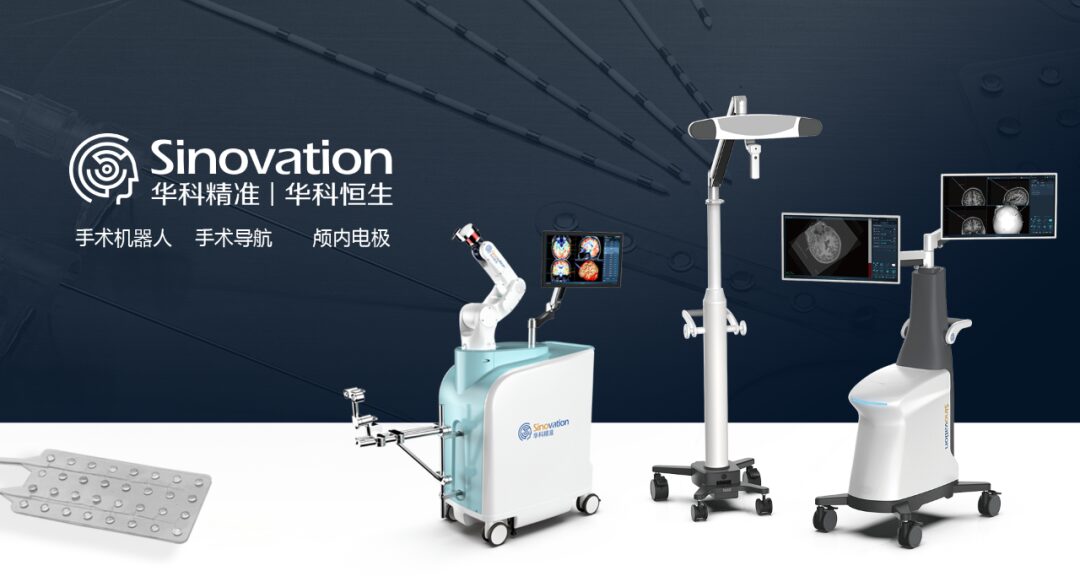

At the same time, as a domestically produced micro surgical robot, the Q300 breaks through the high cost limitations and can fully meet the clinical needs of grassroots hospitals for frame-free stereotactic navigation technology.

In the puncture and suction surgery for hemorrhagic stroke, the Q300 micro surgical robot integrates robotic stereotactic technology with neuro-navigation technology. First, the patient’s head is fixed conventionally, the micro robot module and its supporting components are installed, and adjusted to the approximate area above the entry point. The robot automatically adjusts the angle and direction, then the micro robot module strictly follows the surgical plan set by the doctor, automatically adjusts the position and direction of the guide, and completes precise frame-free stereotactic navigation automatically.

Under the precise guidance of the guide, the doctor can easily perform craniotomy, establish channels, place catheters, perform biopsy suction, and electrode insertion, among various minimally invasive surgical operations. According to the specific needs of the patient’s condition, the Q300 can also assist doctors in the ICU, CT room, and even general wards to carry out fast, precise minimally invasive puncture surgeries.

Issue 81 Huazhong Online | Interview with Zhang Xinding from Lanzhou University Second Hospital: Department performs over 5,000 surgeries annually, robots accelerate the development of the discipline
Issue 80 Huazhong Online | Interview with Liu Fei from Zhongda Fifth Hospital: Robot assistance is more beneficial for the precision of general anesthesia DBS, intraoperative CT verification simplifies the process
Issue 79 Huazhong Navigation Special | Ding Wanhai from Shanghai Sixth Hospital: Suction surgery for hemorrhagic stroke entering the brain ventricle, how navigation achieves “killing two birds with one stone”
Issue 78 Huazhong Online | Interview with Wang Wenbo from Nanjing Hospital: The first 3D structured light ventriculoperitoneal shunt surgery in Guangxi successfully completed, more robot-assisted surgical applications to be developed
Issue 77 Huazhong Online | Interview with Song Jian from Central Theater General Hospital: How robot-assisted SEEG reduces cerebrospinal fluid loss
Issue 76 Huazhong Online | Interview with Zhang Jianzhong from Jiangxi Provincial People’s Hospital: Behind the scenes of Jiangxi’s first robot-assisted DBS surgery
Issue 75 Huazhong Online | Interview with Lou Lin from Zhejiang Provincial People’s Hospital: Large volume of domestic 3D structured light robot-assisted surgery cases and new concepts in hemorrhagic stroke surgery
Issue 74 Huazhong Navigation Special | Interview with Lv Zhongqiang from Hebei Medical University Second Hospital: How to predict fiber bundle pathways through navigation to improve glioma resection accuracy
Issue 73 Huazhong Online | Interview with Hu Shaoshan team from Zhejiang Provincial People’s Hospital on discipline construction in neurosurgery
Issue 72 Huazhong Online | Interview with Liu Qiangqiang from Ruijin Hospital: Application experience of robot 3D structured light and SinoPlan software
Issue 71 Huazhong Online | Interview with Long Hao from Southern Hospital: Robot-assisted surgeries about 200 times a year, occupying half of functional group surgeries
Issue 70 Huazhong Online | Interview with Dou Wancheng from Xiehe Hospital: How to perfectly place SEEG electrodes in a narrow space after two craniotomy surgeries for epilepsy patients
Issue 69 Huazhong Online | Interview with Lou Lin from Zhejiang Provincial People’s Hospital: Awakening of vegetative patients – robot-assisted deep brain electrode implantation surgery
Issue 68 Huazhong Online | Interview with Zhu Junming from Zhejiang University Second Hospital: Robot-assisted epilepsy DBS surgery, perfect avoidance of blood vessels through posterior approach
Issue 67 Briefing | Sanbo Neurosurgery team completes the first robot-assisted awakening surgery for vegetative patients in Chongqing
Issue 66 Huazhong Online | Xu Shuo from Qilu Hospital: Regularly carrying out robot-assisted SEEG treatment for refractory epilepsy case reports
Issue 65 Huazhong Navigation Special | Ma Yuan from Western Theater General Hospital: Application of multimodal neuro-navigation in neurosurgery
Issue 64 Huazhong Navigation Special | Feng Jinzhu from Sichuan Provincial People’s Hospital: How to use neuro-navigation and 3D printing multimodal technology to guide brain tumor resection
Issue 63 Huazhong Online | Interview with Lei Ding: Construction and future development of functional neurosurgery sub-specialty at West China Hospital
Issue 62 Huazhong Online | Interview with the robot surgery team from Shanghai Ninth Hospital: 3D structured light registration is especially suitable for emergency surgeries for hypertensive hemorrhagic strokes
Issue 61 Huazhong Online | Interview with Wang Hongwei from Qilu Hospital: 3D structured light registration is fast and accurate, sharing experiences of robot-assisted biopsy
Issue 60 Huazhong Online | Under the guidance of intelligent robots, balloon compression therapy for trigeminal neuralgia in three cases
Issue 59 Huazhong Online | Interview with Hou Lijun from Changzheng Hospital: Accelerated integration of craniocerebral trauma and hypertensive hemorrhagic stroke treatment, how to ensure surgical safety
Issue 58 Huazhong Online | Interview with Zhao Jianhua and Zhao Heng: First robot-assisted multi-lead electrode implantation for epilepsy in Yunnan Province
Issue 57 Huazhong Online | Yang Jun from Peking University Third Hospital: New generation navigation, 3D structured light registration and DTI multimodal cutting-edge progress in neurosurgery
Huazhong Online Issue 56 | Wu Jinsong from Huashan Hospital: Understanding and clinical application of 3D structured light technology in neurosurgery
Huazhong Online Issue 55 | Interview with Jiang Wei from Wuhan Tongji Hospital: First robot-assisted awakening surgery for vegetative patients in Hubei Province
Huazhong Online Issue 54 | Interview with Bao Min from Shengjing Hospital: Various applications and experiences of robot-assisted surgery, how to improve registration speed and accuracy is especially important
Huazhong Online Issue 53 | Interview with Zhao Rui from Fudan Children’s Hospital: How to achieve multimodal image fusion + intraoperative electrode implantation under 3D visualization for children with FCD
Huazhong Online Issue 52 | Interview with Li Xuesong from Huizhou Third Hospital: First to carry out robot-assisted “puncture first, then resection” surgical mode for tumors near functional areas
Huazhong Online Issue 51 | Interview with Yin Shaoya from Huahu Hospital: How SEEG locates and intervenes in the impact of epilepsy pathways on motor function
Huazhong Online Issue 50 | Hu Jie’s robot-assisted SEEG electrode implantation, how to avoid vascular damage
Huazhong Online Issue 49 | How to apply artificial intelligence and new generation navigation in the treatment of hemorrhagic stroke – Feng Ming from Peking Union Medical College Hospital
Huazhong Online Issue 48 | Hu Jie’s robot-assisted SEEG electrode implantation, how to avoid vascular damage
Huazhong Online Issue 47 | How to apply artificial intelligence and new generation navigation in the treatment of hemorrhagic stroke – Feng Ming from Peking Union Medical College Hospital
Huazhong Online Issue 46 | Interview with Hu Jie: Overview of the development of functional neurosurgery sub-specialty at Huashan Hospital
Issue 45 Briefing | Neurosurgery department of Ganzhou People’s Hospital completes the first robot-assisted SEEG surgery for pediatric refractory epilepsy in the southern region
Issue 44 Briefing | Huazhong Precision Surgical Robot Application Promotion Meeting Held – Report on the 10th National Functional Neurosurgery Academic Conference
Issue 43 Briefing | The team of Li Junju from Hainan Provincial People’s Hospital successfully completes two cases of robot-assisted DBS surgery in the province
Huazhong Online Issue 42 | The team of Shu Kai and Hu Feng from Wuhan Tongji Hospital completes a series of robot-assisted functional neurosurgery after the pandemic
Huazhong Online Issue 41 | Long Hao: New method proposed for intraoperative error correction in robot-assisted general anesthesia frame-free DBS surgery – Comments by Qi Songtao
Huazhong Online Issue 40 | Interview with Gao Yufei and Zhang Jinnan from Jilin University Third Hospital: Robot-assisted puncture drainage surgery for brainstem hemorrhage, how to improve rescue rates
Huazhong Online Issue 39 | Interview with Shan Qiao from Zhengzhou University Fifth Affiliated Hospital: Sharing experiences of over 2,000 surgeries in the department of epilepsy – Comments by Wang Xinjun
News | The first case of magnetic resonance real-time monitoring of intracranial laser ablation (LITT) surgery completed at Beijing Tiantan Hospital
Huazhong Online Issue 37 | Interview with Li Shaoyi from Shengjing Hospital: The department’s surgeries feature functional protection, robot-assisted SEEG insights – Comments by Liu Yunhui
Huazhong Online Issue 36 | Song Shiwei from Fujian Union Hospital: How to comprehensively evaluate preoperative epilepsy foci and functional areas using imaging and electrophysiological information
Clinical Practice | How to reconstruct 3D models of cerebral blood vessels through SinoPlan with one click
Huazhong Online Issue 34 | Liu Qingzhu from Peking University Hospital: Pediatric epilepsy center surgery, how to effectively utilize robots (with related cases)
Briefing | Nature publishes research progress on unmarked positioning technology of surgical robots in China
Huazhong Online Issue 32 | Interview with Wang Jin from Tsinghua Chang Gung Hospital: The value of robot-assisted “puncture-type” surgeries is severely underestimated, functional neurosurgery best reflects the integration of medicine and engineering
Huazhong Online Issue 31 – NeuroSurgery: A retrospective study of 100 patients proves that LITT is a new method for treating intracranial tumors and epilepsy – Comments by Zhang Kai from Tiantan Hospital
Surgical Video Call for Submissions | World Chinese Neurosurgery Academic Conference Young Physicians Spinal Surgery Skills Competition
Huazhong Online Issue 29 | Chen Fuyong from Shenzhen University General Hospital: Experiences in epilepsy surgery and robot-assisted SEEG/DBS surgeries
Huazhong Online Issue 28 | Guo Mian from Harbin Medical University Second Hospital: How to use robots to solve the precision problem of deep brain hemorrhage puncture, including hematoma puncture flowchart | Comments by Jiang Chuanlu
Issue 27 – Briefing | Surgical planning software SinoPlan free version released online
Huazhong Online Issue 26 | Zhu Junming from Zhejiang University Second Hospital: Clinical application frontiers of Sino neurosurgical robots, from image fusion to surgical approach design
Huazhong Online Issue 25 | Interview with Cai Lixin from Peking University First Hospital: Rapid growth of pediatric epilepsy surgeries in the country but facing three major development bottlenecks
Huazhong Online Issue 24 | Interview with Tao Wei from Shenzhen University General Hospital: The department has established itself for two years, pain treatment has become a growth point for functional neurosurgery
Huazhong Online Issue 23 | From hemorrhagic stroke to DBS, detailed explanation of five major indications for robots in neurosurgery – Liu Changqing from Chongqing Sanbo
Huazhong Online Issue 22 | Yang Zhiquan from Xiangya Hospital: Efficacy analysis of bilateral Gpi-DBS for Meige syndrome
Huazhong Online Issue 21 | A new registration system for robot-assisted DBS surgery in neurosurgery research – Guo Yi from Peking Union Medical College Hospital
Huazhong Online Issue 20 | Mind-controlled robotic hand team from Zhejiang University Second Hospital completes the first domestic implantation of brain-machine interface technology
Huazhong Online Issue 19 | Interview with Xu Jiwen from Renji Hospital: Why preoperative MRI must be done with 1mm thin layer scans for SEEG
Huazhong Online Issue 18 | Interview with Qi Songtao from Southern Hospital: Research progress on hypothalamic injury repair mechanisms will change which neurosurgical procedures
Huazhong Online Issue 17 | Yang Zhiquan from Xiangya Hospital: Robot navigation and image post-processing technology promote and change the development process of functional neurosurgery
Huazhong Online Issue 16 | Interview with Wang Guangzhi from Tsinghua University: Four steps to develop neurosurgical robots, perception capability is key
Huazhong Online Issue 15 | Interview with Zhang Shizhong from Zhujiang Hospital: Reflections on twenty years of DBS surgery for Parkinson’s disease and how to eliminate potential risks
Huazhong Online Issue 14 | Interview with Li Yunlin from Capital Institute of Pediatrics: The direction of pediatric epilepsy surgery is more minimally invasive, what applications do robots have
Huazhong Online Issue 13 Special Interview | Shi Jianguo and Gao Zaifen from Qilu Children’s Hospital: Completion of the first robot-assisted SEEG surgery for pediatric refractory epilepsy in Shandong Province
Huazhong Online Issue 12 | Interview with Li Shiting from Xinhua Hospital: Cranial nerve function is the last “fortress” of neurosurgery, the department’s annual surgery volume will exceed 4,000
Huazhong Online Issue 11 | Zhang Kai from Tiantan Hospital: Six advantages of robot-assisted surgery in SEEG applications
Huazhong Online Issue 10 | Interview with Zhou Wenjing: 3D reconstruction and image fusion software are the biggest advantages of domestic surgical robots | Comments by Zhang Yuqi
Huazhong Neurosurgery Online Issue 9 | Interview with Yang Xuejun: The launch of the neurosurgical equipment development project for real-time identification and removal of residual and infiltrative parts of gliomas
Huazhong Neurosurgery Online Issue 8 | Interview with Zhang Jianmin from Zhejiang University Second Hospital: The unstoppable trend of interventional cerebrovascular techniques, neurosurgeons must participate to enhance effectiveness
Precision in Surgery Issue 7 | Interview with Zhang Jianmin from Zhejiang University Second Hospital: Overview of the department’s 60-year development and the characteristics of surgical robots and other technical equipment in composite operating rooms
Precision in Surgery Issue 6 | Where are the advantages of robot-assisted SEEG surgery and how its application range will continue to expand – Zhu Junming from Zhejiang University Second Hospital
Precision in Surgery Issue 5 | Zhu Junming from Zhejiang University Second Hospital: What advantages does robot-assisted DBS surgery have besides precision | Comments by Zhang Jianmin
Precision in Surgery Issue 4 | What breakthroughs are there in registration methods and time for robot-assisted DBS surgery – Guo Yi from Peking Union Medical College Hospital
Precision in Surgery Issue 3 | Interview with Li Jianyu from Xuanwu Hospital: How to use surgical robots to improve the accuracy of DBS implantation
Precision in Surgery Issue 2 | [Update] Discussion transcript: What are the safety bottom lines and breakthroughs for artificial intelligence in neurosurgical robots
Precision in Surgery Issue 1 | Discussion transcript: Besides replacing the head frame, what kind of surgical robots does epilepsy surgery need
Precision in Surgery

Precision in Surgery Weekly is jointly produced by Huazhong Precision and Neurosurgery Frontline New Media, aiming to promote the precision of neurosurgical operations through case reports. Industry experts are welcome to contribute and support; reproduction must indicate the source and ensure the integrity of the article, contact email: [email protected].